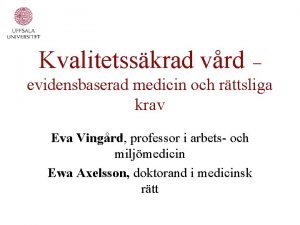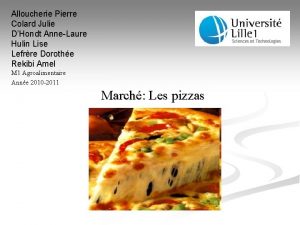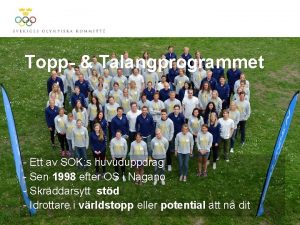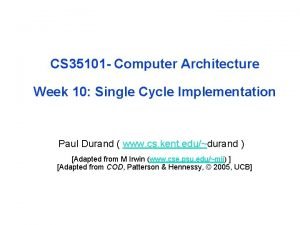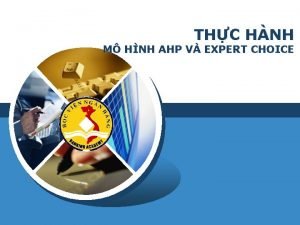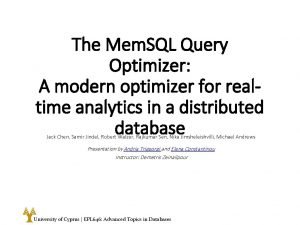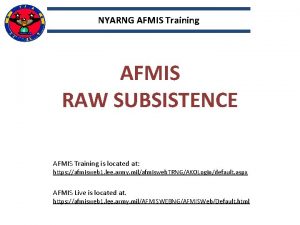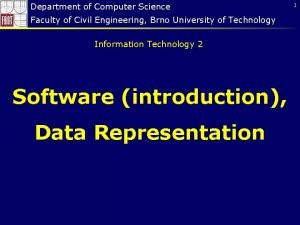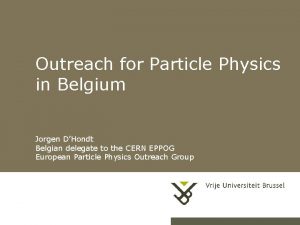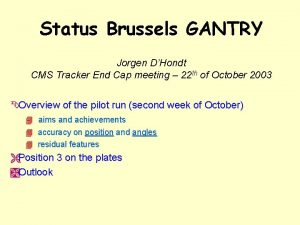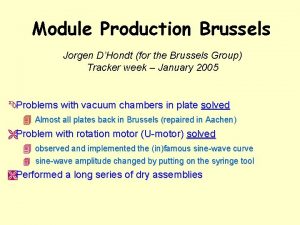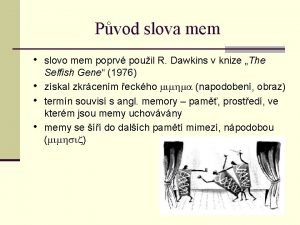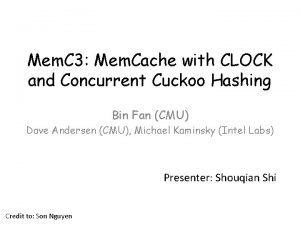MEM Statistics Jorgen DHondt I was asked to

















- Slides: 17

MEM Statistics Jorgen D’Hondt I was asked to entertain this discussion session My interpretation: quick overview of some key issues, and stimulate discussion MEM workshop – CP 3 – May 2013

MEM Statistics Jorgen D’Hondt The master formula from theory to experiment pheno theory experiment http: //w 3. iihe. ac. be/~jdhondt/Lecture-Theory. Vs. Exp-DHondt-Natal 2012. pdf MEM workshop – CP 3 – May 2013

Event-by-event analysis Jorgen D’Hondt The MEM master formula (at least a sketch, simplified notation): for each event Including nuisance parameters (alpha) :

Using the MEM output Jorgen D’Hondt The MEM master formula (at least a sketch, simplified notation): for each event

Using the MEM output Jorgen D’Hondt The MEM master formula (at least a sketch, simplified notation): for each event Absolute “likelihood” to construct an estimator Relative “likelihood ratio” to compare (a possible) Signal to Background eg. Neyman-Pearson variable

Using the MEM output Jorgen D’Hondt The MEM master formula (at least a sketch, simplified notation): for each event Absolute “likelihood” to construct an estimator Relative “likelihood ratio” to compare (a. M possible) EM Signal to Background : in pri nciple optima eg. Neyman-Pearson variable l

Using the MEM output Jorgen D’Hondt The MEM master formula (at least a sketch, simplified notation): for each event Absolute “likelihood” to construct an estimator Typically SM measurements Relative “likelihood ratio” to compare (a possible) Signal to Background Typically BSM searches eg. Neyman-Pearson variable

Using the MEM output Jorgen D’Hondt The MEM master formula (at least a sketch, simplified notation): for each event Absolute “likelihood” to construct an estimator Use as probability !! Relative “likelihood ratio” to compare (a possible) Signal to Background Use as variable !! eg. Neyman-Pearson variable

Using the MEM output Jorgen D’Hondt The MEM master formula (at least a sketch, simplified notation): for each event Absolute “likelihood” to construct an estimator Use as probability !! Relative “likelihood ratio” to compare (a possible) Signal to Background Use as variable !! Footnote: uncorrelated variables PS and PB eg. Neyman-Pearson variable

Using the MEM output Jorgen D’Hondt Absolute “likelihood” to construct an estimator • • Aim: optimal estimator (closer to the Minimum Variance Bound) Need simulation to calibrate P(q) to a consistent L(q) probability The rescaling factor C is very important Everything can be absorbed in a “black-box” pull correction Relative “likelihood ratio” to compare S & B • • Use as probability !! Use as variable !! Aim: optimize discrimination power between Signal and Background Need simulation for a template of the “likelihood ratio” variable The rescaling factor C is not important The pull is not important

Using the MEM output Jorgen D’Hondt Absolute “likelihood” to construct an estimator • • Use as probability !! Aim: optimal estimator (closer to the Minimum Variance Bound) Need simulation to calibrate P(q) to a consistent L(q) probability The rescaling factor C is very important Everything can be absorbed in a “black-box” pull correction Controlling the statistical properties is very important ! Relative “likelihood ratio” to compare S & B • • Use as variable !! Aim: optimize discrimination power between Signal and Background Need simulation for a template of the “likelihood ratio” variable The rescaling factor C is not important The pull is not important Controlling the statistical properties is less important !

Key feature of MEM Jorgen D’Hondt

Key feature of MEM Jorgen D’Hondt Hence we (always) simplify !

Key feature of MEM Jorgen D’Hondt Hence we (always) simplify ! ① Absolute: P ≠ probability ② Relative: P = less optimal variable

Key feature of MEM Jorgen D’Hondt Hence we (always) simplify ! ① Absolute: P ≠ probability Calibrate using your best knowledge with data or simulation, or normalize to P(a. SM) ② Relative: P = less optimal variable Check how much less sensitive you become to differentiate Signal & Background

Key feature of MEM Jorgen D’Hondt Hence we (always) simplify ! ① Absolute: P ≠ probability Calibrate using your best knowledge with data or simulation, or normalize to P(a. SM) … eg. which path to follow ? ② Relative: P = less optimal variable Check how much less sensitive you become to differentiate Signal & Background … eg. how to recover sensitivity of radiation ?

General Wtb vertex physics Jorgen D’Hondt • Flavour physics is a key domain and challenge in HEP • Understanding the mass and mixing patterns is an open issue and relates to fundamental aspects like CP-violation • Deviations from the SM expectation in flavour changing processes would be an important discovery of new physics; new interactions at higher energies may manifest themselves as effective couplings of the SM fermions • The W-t-b vertex is an excellent study case for this research Vtb ~ 1 (SM) 0 (SM) these “form factors” have complex phases 8 degrees of freedom ! eg. VL, R = Re(VL, R). eif(VL, R) if CP is conserved the couplings can be taken as real ( 4 degrees of freedom)

